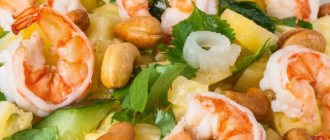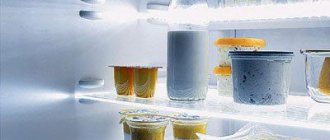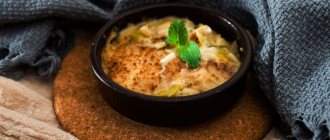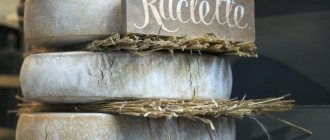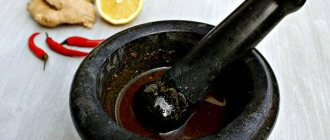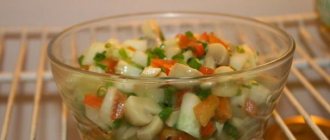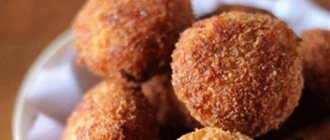It is clear that the peculiarity of this group of cheeses is the mold itself. What shocks the inhabitants of the post-Soviet space is nothing more than a penicillin fungus - Penicillium Cand > It turns out that mold cheeses have been eaten since time immemorial. This is only a novelty for us, but in decent restaurants of pre-revolutionary Russia, Roquefort and Camembert cheeses were served with fine wines and were favored by the aristocracy. Blue cheeses are a delicacy product and are highly valued. We will designate the most famous varieties of blue cheeses by name:
- Roquefort is a famous cheese made from sheep's milk, and the mold for the cheese, Penicillium roqueforti, is grown on rye bread and then introduced into the head of the cheese using special knitting needles coated with mold spores. This cheese matures in special caves in the province of Rouergue in France, where the walls are covered with the same mold and where humidity and temperature are maintained at a constant level. If a cheese called Roquefort is made elsewhere, then it is not Roquefort, but a replica of it.
- Gorgonzola is a cheese of Italian origin. It is prepared in Piedmont and Lombardy. The fungus Penicillium glaucum is planted, and special metal rods are inserted into the cheese heads to provide ventilation. Gorgonzola ripens 4 months and is about 200 years older than Roquefort. It has a sweetish taste and very beautiful blue stains of mold on the cut.
- Danablu is a blue cheese made on an industrial scale in Denmark. This is Roquefort's democratic double. Nevertheless, it is manufactured using original technology, is known all over the world and has the status of Protected Geographica lIndication, that is, it can only be produced in Denmark.
- Stilton is an English blue cheese. These cheeses are made in the counties of Derbyshire, Leicestershire and Nottinghamshire. The pattern of mold on this cheese is interesting - the passages dug by the mold in the cylindrical head of the cheese diverge from the center of the head to the edges, like rays. It is made from pasteurized cow's milk and aged for at least 9 weeks. This is an excellent alternative to Roquefort and Gorgonzola, although it is several centuries younger than them. Stilton began to be released for sale only in the 18th century.
What are the benefits of blue cheeses?
This is not only a delicious and delicious product, it is also incredibly healthy. It is believed that eating 50 grams of blue cheese daily will allow you to:
- Forget about migraine headaches.
- About pain in the stomach and intestines caused by unfriendly bacteria, after all, the cheese contains full-fledged penicillin, which will give the cheese a piquant taste and smell, and heal, if necessary.
- The calcium contained in blue cheeses is completely absorbed, which is why this cheese is recommended for older women who are prone to osteoporosis.
- Vitamins B1 and B12 contained in these cheeses provide an irreplaceable service to the central and peripheral nervous system, covering the nerve endings in the myelin sheath, due to which nervous excitability is reduced significantly.
- The essential amino acids valine and histidine, together with milk fat, contribute to the rejuvenation of body tissues, this should also be taken into account.
- And histidine and tryptophan help produce serotonin in sufficient quantities to enjoy life and not become depressed.
- Blue cheeses contain vitamin K, which improves the rheological properties of blood and prevents blood clots.
And in the end, these are simply amazingly delicious cheeses with a piquant taste and smell.
Shrimp Pasta and Pesto
We will need: half a kilo of thin Italian spaghetti, a glass of peeled and cooked shrimp, a spoon of olive oil, a couple of tomatoes, a little onion and garlic, and of course, Pesto cheese in the amount of 120-150 grams.
- Place water in a saucepan to boil to cook spaghetti.
- Meanwhile, chop the onion and crush the garlic.
- Cut fresh tomatoes into small cubes.
- Sauté the onion and garlic in oil in a frying pan. When the onion becomes transparent, add shrimp.
- Then we add tomatoes there too.
- The water has boiled: cook the spaghetti (you can undercook it a little) - the cooking time is usually indicated on the package.
- Place the pasta in a colander and dry lightly to remove unnecessary moisture.
- Add the spaghetti to the frying pan (by the way, it needs to be quite large) to the sauce and stir.
- Three coarse Pesto on a grater and sprinkle the dish with it.
- You can simmer a little more - just a couple of minutes.
- Ready! Place on plates and serve in portions.
Bon appetit to you all and see you new recipes!
What do you eat with blue cheese: rules of etiquette and combination with dishes
Consumption of blue cheeses requires adherence to certain rules and etiquette. The right cheese must be served correctly. It's good to know when and how mold cheeses are served:
- Blue cheeses are served for dessert, with fruit and wine.
- Wine for cheese is chosen with a high tannin content, since the cheeses themselves have an unusual piquant taste. It would be good if several brands of wine were served.
- Blue cheeses should be served on a wooden round tray in one piece with a special string for slicing cheeses.
- If a cheese dish is served, then cheeses of various brands are laid out in a circle in rows, starting with soft white cheeses. The next rows are cheeses with a richer taste. The center of this cheese circle is always blue cheeses; as a rule, Roquefort and Gorgonzola occupy the very center. This creates a large circle of cheese. Its appearance is a colorful sight.
- If the cheeses are laid out on a dish, then each type of cheese can be cut into different shapes - rhombuses, triangles, squares.
- Very soft cheeses are not cut at all, but served in large pieces, otherwise there is a risk that they will spread over the dish.
- A special cheese knife and string are used to cut cheeses. What you use for slicing depends on the quality of the cheese and its consistency.
Serving blue cheese is not so difficult as how to correctly take it from the dish, and what plate to use, as well as what to eat it with. There are certain rules about this:
- Cheese from a common dish served on the table is taken with a special cheese fork with two prongs.
- It is supposed to be eaten using a knife and fork, or in extreme cases, only a fork.
- You can only eat Chechil and Suluguni cheeses with your hands, undoing the braids and putting them in your mouth.
- You can also eat cheese with bread; it is served in a separate plate in the form of toast. The bread must be dark.
- Fruits that go well with mold cheeses are grapes, figs, peaches, dates, quince and kiwi.
- You can serve honey and jams from the fruits listed above with the cheeses.
- You can serve cashews, almonds, peanuts and walnuts.
These are the general rules for serving mold cheeses and the culture of their consumption.
An infrequent product on the table is blue cheese, the benefits and harms of which few know. Those who want to try the delicacy should familiarize themselves with its features and how to use the product correctly.
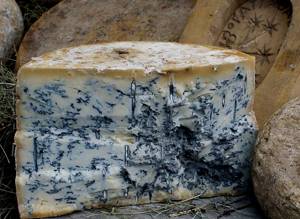
What to serve with noble cheeses
First of all, you should place the cheeses correctly on the plate. It is customary to place cheeses with the most delicate taste first, for example, the Furm Dumbler variety with blue mold. Thin slices of delicate cheese are laid out in a circle on the edge of the plate, followed by cheeses with richer and more piquant flavors. To avoid mixing, it is worth alternating cheese with fruits and mint leaves. The sweet and sour taste of apples and grapes will perfectly complement the spiciness and pungency of cheeses. Avocado will absorb the aroma and perfectly emphasize the cheese taste. Mint has a refreshing taste, makes cheeses softer, but does not contribute to the loss of their piquancy.
Almonds and walnuts go well with blue cheeses. They can be placed in small bowls and placed on a plate with cheeses, or you can fill the gaps between the slices with nuts.
The French usually serve noble cheeses in combination with bread. You can cut the cheese into small pieces and stick them on a skewer along with the bread. It will be especially piquant if the bread is topped with raisins.
The final touch is the selection of wine to pair with the cheese plate. It is worth remembering that the sharper the taste of the cheese, the brighter the taste of the wine should be. It would be ideal to pair with red French wine. Blue cheeses should be served with fortified red wines. The wine must have a minimum amount of sugar and must be chilled.
A plate of noble cheeses will be an excellent addition to a festive banquet. In order for guests to appreciate the spiciness of the dish, it is worth serving it with the above-listed products and wines.
How is blue cheese made and can it be eaten?
The first reaction to moldy cheese is the desire to throw it away. This is true for the familiar dairy products. The appearance of mold indicates that the cheese is spoiled and eating it can cause severe poisoning.
There are many varieties of blue cheeses, each prepared according to special recipes using domesticated penicillin fungi. Manufacturing has centuries-old traditions, and the craftsmen have their own secrets. There are hard and soft types, milk is taken from cows, sheep, goats. The strains of fungi are also different, the first difference that catches your eye is the color: blue, white, red. Technologies vary depending on the mold used.
Why is cheese bitter?
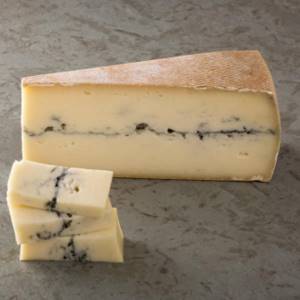
Each product has its own specific taste. Some types of cheese, for example, blue or hard, have a spicy bitterness, which does not at all indicate their poor quality. This is a feature of the product that some may like and others may not. In other cases, bitterness may indicate poor quality of the product.
There may be several reasons why cheese tastes bitter:
- The product has spoiled. If the storage conditions are not met, the creamy fats in cheese undergo oxidation. As a result, the product acquires a specific bitter taste. They also say that it is rancid.
- Violation of cheese making technology. In particular, the product could ripen at temperatures above or below 9-10 °C, which is unacceptable.
- Using low-quality cow's milk to make cheese. If the animal was fed wormwood, lupine or other plants that contain glucosides, the milk takes on an unpleasant taste. As a result, all products made from it will taste bitter.
- Adding calcium chloride to milk, which helps the product coagulate better, but at the same time makes it bitter.
Chemical composition and calorie content
The products are valuable minerals: potassium, calcium, sodium, phosphorus, magnesium, iron, selenium, fluorine. Microelements are completely absorbed thanks to lecithin, which is in the product. There are relatively few vitamins: A, B, C, E, K. Contains many natural proteins, which are quickly and easily processed, turning into a source of human energy. Cheeses are valuable for their content of amino acids, which the human body does not synthesize but receives from food.
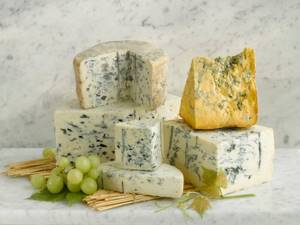
Each variety has some differences in chemical composition and calorie content. The average nutritional value is 350 kcal per 100 g. The delicacies contain fat (30%) and proteins (20%). There are no carbohydrates at all.
Under the influence of cultivated mold, changes occur in the chemical composition. The alkalinity of the product increases due to the neutralization of lactic acid. Amino acids are formed from protein, which improves the taste of the product. Sometimes the action of fungi spreads to the fat, and the cheese develops a unique aroma. Ripening is accompanied by enrichment with B vitamins.
Features of green cheese
A distinctive feature of green cheese is its salty and spicy taste, as well as an amazing cheese aroma. Unlike its counterparts, this type of cheese is quickly digestible, and the feeling of fullness does not leave the taster for a long time. It is also curious that green cheese has virtually no characteristic smell of mold or its bitterness.
The composition of the cheese simply pleases the body, these are: - microelements, - minerals, - vitamins of different groups.
The product contains natural proteins, but there are practically no carbohydrates. A small amount of this cheese will not harm your health, but you should not consume it in excess.
Types and names of blue cheeses
Each type of cheese differs in the method of preparation, the strains of fungi used, and the milk. All this affects the characteristics of the fermented milk product. The names of the species depend on the color of the mold.
With blue mold
Blue cheese is riddled with streaks of mold. Its spores are introduced with special needles, and air access is provided during the ripening process. Contains penicillin, which does not harm the body with moderate consumption of the product.
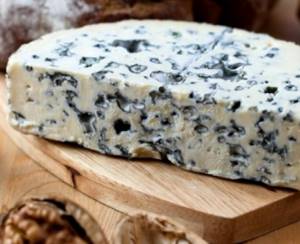
- Roquefort is a spicy, spicy cheese. For its classic production, only goat's milk and mold from caves in the mountains of southern France are used.
- Dorblu - appeared in Germany more than 100 years ago. It has a creamy, dense texture, with a marbled pattern created by mold. A product with a sharp spicy taste reminiscent of nuts and mushrooms.
- Gorgonzola with a spicy aroma comes from Italy. Young cheese is soft, but after 4 months of ripening it becomes dense.
- Danablu is a salty, pungent cheese with a white texture and a marbled pattern of blue veins of mold.
- Stilton is from England, the raw material for production is cow's milk cream. The structure is brittle, the color is creamy, the aroma is fruity.
All blue cheeses are snack foods, high in fat, spicy, slightly salty.
With white mold
This mold does not grow inside like blue mold, but covers the cheese head with fluff. It has the most delicate, refined taste, similar to mushroom. The strains are not introduced into the fermented milk product; they themselves settle on it from the air, which is saturated with spores in the room where the cheese is aged. 4 varieties are in greatest demand:
- Camembert is made from cow's milk. It has a mushroom aroma and high fat content.
- Brie has a rich spicy aroma and a delicate creamy taste. Gourmets prefer varieties that have a soft crust.
- Neuchatel is a cheese with a deep mushroom aroma and a grainy structure.
- Spicy Boulette d'Aven - has a granular, loose structure.

White cheeses are served for dessert. Mold promotes rapid digestion of all food consumed.
With red mold
These are exotic varieties with a crust of red shades. This is what it becomes after processing the cheese wheels with alcoholic beverages.
- Livaro is prepared from the highest quality fatty cow's milk, adding vegetable juices and sea cane. The product has a distinct pungent taste.
- Reblochon - orange crust covered with white fluff.
- Epoisse is a soft type of cheese with a velvety consistency. The crust is dark orange in color and is obtained by washing in brandy. The heads are small, the traditional packaging is wooden boxes.
- Limburg cheese is a semi-soft cheese. The aroma is reminiscent of the smell of unwashed feet, so only gourmets can appreciate the product.
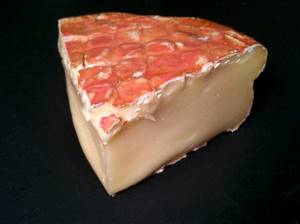
Health Benefits
Fungi add health benefits to cheeses. Product properties:
- help absorb calcium;
- synthesizes melanin, which resists harmful ultraviolet radiation;
- improve the functioning of the gastrointestinal tract;
- have a beneficial effect on hormone production;
- accelerate wound healing.
There are more benefits in goat milk products: less fat, less calories, and better digestible.
Rich source of phosphorus
Healthy bones and teeth are impossible without phosphorus, which all blue cheeses are rich in. They are useful for children and prevent the development of rickets. Phosphorus is also involved in many other processes occurring in the body.
Improves memory
Fermented milk products with mold nourish the brain with valuable substances. Memory improves and the risk of developing diseases associated with memory impairment is reduced. Useful at an early age for the development of mental abilities, in old age to prevent memory problems. Helps people of any age, especially with heavy loads on the brain.
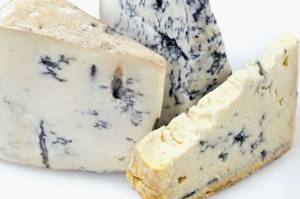
Strengthens immunity
Minerals and vitamins are well absorbed by the human body, increasing immunity. Calcium, sodium, zinc, and vitamin A play a special role in this. A healthy immune system is better able to resist diseases.
Fights arthritis
The problem of many older people is joint disease. Thanks to penicillin, such cheeses relieve inflammation and pain. It is not possible to get rid of arthritis completely, but it becomes inactive and the patient’s well-being improves. Also used for prevention.
Good for the heart
Vitamin K and other substances entering the body along with cheese and fungi have a beneficial effect on the heart muscle. People's cholesterol levels are reduced, blood vessels are strengthened, and the likelihood of blood clots is reduced.
Prevents osteoporosis
Weakening of bones and a tendency to destruction are more typical for women. Calcium, which plays a key role in strengthening bones, helps prevent osteoporosis.

Milk protein
Some people cannot drink milk due to lactose intolerance. The source of milk protein for them is cheese, which the body tolerates without complications.
Prevention of dental problems
Cheese contains a lot of calcium, which strengthens teeth. In addition, it prevents the development of caries and plaque.
Anti-inflammatory properties
All varieties are endowed with an anti-inflammatory effect, which is due to the presence of penicillin in the product. This helps prevent health problems and even fatal consequences.
Fights cellulite
Women value it for its anti-cellulite properties. Regular consumption prevents the formation of scars and swelling on the skin.

Blue cheese for weight loss
For those who have problems with excess weight or are watching their figure, consuming a lot of cheese is not recommended for the following reasons:
- a large amount of sodium, which retains fluid in the body;
- high fat content;
- a lot of protein, which makes it difficult to maintain a balance in nutrition.
But there are soft blue cheeses, such as mozzarella, camembert and brie, which are low in fat and gentle on the figure. When losing weight, follow the rules:
- take the product 3-4 times a day for breakfast, snack and early dinner;
- consume no more than 100 g per day, each piece - 25 g;
- include in the diet 2-3 times throughout the week.
Green cheese production
The energy value of green cheese is about 356 kilocalories. So people on diets should not indulge in such delicacies.
The technology for producing such cheese consists of several stages. First, skim milk is pasteurized, then blue fenugreek spice from fresh seeds is added to it for a piquant taste, as well as a choice of citric or acetic acid.
The second stage is the reaction of the milk, which begins to curdle and form whey. After this mixture is poured into specially prepared molds and left for a week.
The third step is to hang the heads of cheese so that they ripen and have a distinctive taste. The cheese is hung for up to 6 months, the minimum ripening time is 2 months.
The cheese turns green at the first stage when mixing ingredients such as blue fenugreek and yellowed milk mass.
In modern production, blue fenugreek has been replaced by a plant called sweet clover.
The benefits of different types of blue cheese
The product is useful, there is no doubt about it. Differences in structure, appearance, and properties are determined by the content of microelements and composition.
Dor blue
Helps quickly restore strength after injuries and operations, stops bleeding. The variety has a high calorie content (more than 350 units), so it is recommended for heavy physical activity. Increases immunity, helps restore the nervous system after stress. Has the ability to neutralize carcinogenic substances.
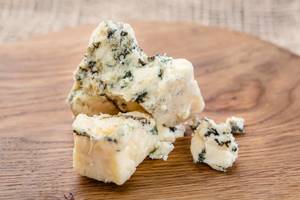
Gorgonzola
The variety is useful for people with problems in intimate relationships. It stimulates, activates sexual functions, helps to establish harmony in married life. In addition, it contains many peptides that prevent the formation of blood clots. It has good antioxidant properties and has a beneficial effect on the immune system.
Roquefort
This product has the following beneficial properties:
- prevents and treats diseases of the cardiovascular system;
- is able to relieve inflammation, helps relieve symptoms in patients with arthritis, gout;
- prolongs youth, preventing the formation of wrinkles and cellulite;
- restores the balance of minerals, amino acids, vitamins.
Stilton
The variety is recommended for people who have problems with high blood cholesterol. The product contains a lot of choline, which stabilizes its quantity. Ascorbic acid serves to strengthen the immune system.
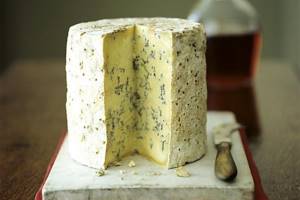
The benefits of Pesto Green cheese
This product is believed to be beneficial. This opinion about it was formed thanks to the vitamins and minerals that it contains.
- Normalization of the nervous system occurs under the influence of sodium.
- It contains ascorbic acid, which has a positive effect on the immune system.
- There is even a component that has a beneficial effect on the functioning of the cardiovascular system. We are talking about the effects of potassium and magnesium.
- It is equally important that the functioning of the gastrointestinal tract and liver is improved.
Therefore, doctors claim that this combination has a general strengthening effect on the human body.
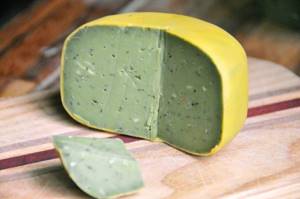
Contraindications for use
There are no strict contraindications for use. The only reason why a person will have to give up enjoying the taste of this delicacy is individual intolerance to the components of the product. To detect this, it is necessary to monitor the effects on the body.
If, when taking it, a person develops and intensifies an allergic reaction, then he should stop eating Pesto and make sure that the allergy was specifically to this product.
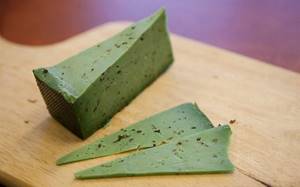
How to eat blue cheese correctly
Cheese with benign mold is a product that is eaten for dessert; daily consumption is not accepted. Serve on the table cut into thin pieces. The greatest benefit is in the evening, because at this time calcium is absorbed to the maximum. Served as a separate dish or together with other types.
Traditionally, cheese is served with wine, which is chosen depending on the type. Soft white bread goes well with all varieties except Roquefort. Fruits and grapes highlight the taste.
What can be prepared from the product
Spicy cheeses are used to make spaghetti sauces. Products with blue mold are grated or served in salads. They bake pies and prepare soups. Good snacks are hot toast with cheese, nuts, and tomatoes.
Sandwiches are often prepared:
- Warm white bread toasts have their crusts cut off. Spread with Roquefort, ground with butter.
- Mix brie and Dijon mustard. Spread the pita bread, roll it into a tube, and put it in the refrigerator for a day. Sliced diagonally for the table and served with wine or grape juice.
- The pear is cut into slices, with pieces of dor blue on top.
How to remove bitterness from cheese?
#1
There are a huge number of varieties of cheese. They differ both in their taste and in the methods of production and storage. Bitterness in cheese does not always mean that the cheese is spoiled. Some varieties (blue cheeses, hard cheeses) have a bitter taste, and you should not be afraid of this, since these are their taste qualities. In other cases, bitterness may be a sign of poor quality of the product.
#2
Bitterness can be caused by poor quality milk, or by violation of storage and sales conditions. What to do if the cheese is bitter? Depending on the variety, the procedure may vary. Brynza, feta, Adyghe, Georgian cheese may be slightly over-salted, which will cause a change in taste. How to remove bitterness from cheese in this case? It is enough to soak the cheese for one or two hours in cool boiled water to remove the bitterness.
#3
For hard cheeses, the appearance of bitterness almost always means that storage conditions were violated: the cheese was frozen and thawed several times. Hard cheeses can indeed be stored for up to three months in the freezer, but upon further use, freezing is not allowed again. Hard cheese with signs of bitterness can be used in the form of crumbs for making pizza or spaghetti.
#4
Hard cheeses are stored at a temperature of 10-12 degrees, semi-hard cheeses - 5-8 degrees. Soft cheeses that have bitterness cannot be corrected and will have to be thrown away. Stale, not rancid cheese, however, can be corrected by dipping it in milk for 10-15 minutes. Soft cheeses (Camembert, mozzarella) are very delicate, and if the cheese is bitter, this is a sign of poor quality. In other words, the raw material (milk) had an off-flavor.
#5
Improperly storing cheeses in the refrigerator can also cause rancidity. They perfectly absorb foreign odors and transmit their own. Cheeses stored in the refrigerator should be separated from other products or wrapped in water-repellent film. Outside the refrigerator, cheeses are stored in a cool place in a cloth previously soaked in a salty solution.
#6
Feta, feta cheese (so-called pickled cheeses) should be stored in a salted solution with a strength of 16-28%. Knowing the properties of different types of cheese can always be useful in determining the quality of this product. Before throwing away cheese, make sure it is hopelessly spoiled.
Homemade recipe
Those who decide to cook Dor Blue on their own should buy 50 g of it. In addition, you will need:
- 3.5 liters of homemade milk;
- 6 tablets of acidin-pepsin;
- 2 tbsp. l. salt.
- Heat the milk to +35°C. Take it into a glass and stir in the mold collected from half of the purchased cheese. Let stand for 1 hour.
- Pepsin is crushed and dissolved in warm water (100 ml). Pour solutions with mold and tablets into milk and mix. Cover and place in a warm place for 1 hour.
- During this time, a jelly clot and yellowish whey are formed. The thick mass is cut into pieces right in the pan.
- After 15 minutes they will settle to the bottom, then they are collected with a slotted spoon. Place in a colander or a special cheese mold.
- The product is not pressed, the serum is allowed to drain. Gently turn over periodically. After 12 hours, wipe with salt and leave to dry on a tray with holes.
- Collect the remaining half of the mold, dilute it in warm milk (50 ml), and leave for 1 hour. Then this mixture is introduced into the cheese, after making holes.
Prepare 2 plastic sterile containers: a larger one and a smaller one. Many holes are made in the latter. Place cheese in it, and pour 1 tsp into a large container. boiled water. Place the smaller dishes in the larger ones, cover with a lid, but not airtight. The cheese ripens at room temperature for a week or a little more, during which time mold grows. The product is turned over every 2 days.
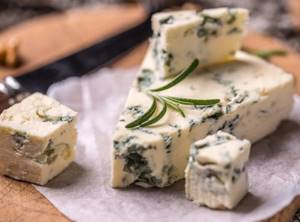
Using Chanakh cheese in cooking
Often, salty Armenian cheese is served as an independent snack. It is placed on the table in brine, which you can drink afterwards. The product itself is cut into portions. It can safely play the role of an aperitif. Pickled cheese can stimulate the appetite and prepare the stomach for a full meal.
Chanakh cheese is popular in cooking along with other types of cheeses. It can be added to vegetable, meat, fish, and fruit dishes. They make cheese plates and grate them into soups. Armenian cheese goes well with viscous honey and wine. It is also served as a gourmet snack. The product responds well to heat treatment. A delicate cheese crust will be obtained if you grate the “Chanakh” 5 minutes before the end of cooking.
Armenian cheese is stored well in brine. In a strong marinade you can preserve the product for about 2 months. To get the maximum benefit and taste from Chanakh cheese, it should be consumed without brine for a week. Among other things, when storing in the refrigerator, you need to choose the optimal temperature for the product.
How to choose the right quality blue cheese
First of all, you should buy cheese from reliable stores. Pay attention to the following points:
- date of manufacture;
- best before date;
- storage conditions.
They look at the texture: for high-quality cheese it should be soft and loose, without holes. A good product is whole and does not fall apart.
Blue cheese has a strong, pungent mushroom smell, reminiscent of penicillin. In the place of the crack, colored inclusions are visible. If the mold is solid, the product was prepared a long time ago, it is not recommended to buy it.
White varieties have a delicate aroma, the smell of ammonia indicates spoilage. The surface is covered with fluff or crust, and when cut it is white. Only brie noir has a pink tint, but it is rarely found on the shelves.
Green Cheese Pesto Recipe
The preparation scheme is no different from the Gouda recipe.
- First of all, rennet is added to the starter.
- Once this is done, garlic is gradually poured into this mass.
- Then set the selected temperature at which the mixture begins to thicken and curdle.
- The next step is to remove the whey. To do this, the resulting product is washed and pressed. This way you can remove moisture.
- Once the product has hardened, it is placed in brine.
- Then they take it out and send it to ripening. This process takes place in special rooms in which certain conditions are maintained.
The fat content of the prepared cheese does not exceed fifty percent.
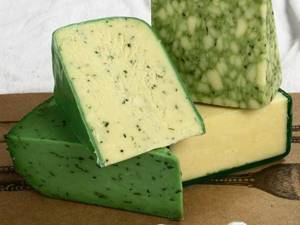
How to choose a cheese product and under what conditions to store it?
Before you buy, make sure you are satisfied with the composition. Be sure to pay attention to the expiration date. Natural cheese is stored for only a few days. You can extend this time if you put the product in cling film or wrap it in paper and then put it in the refrigerator.
Potential dangers and contraindications
Consumption of cheese with healthy mold does not cause contraindications for most people. The product is dangerous only for some consumers:
- Allergic to penicillin.
- Suffering from fungal diseases, including thrush.
- People suffering from arthritis, polyarthritis, asthma, neurodermatitis, hormonal system disorders.
- With gastrointestinal disorders: peptic ulcers, enterocolitis, pancreatitis.
Should not be consumed by pregnant or breastfeeding women. They may experience fever, vomiting, and diarrhea. This can lead to miscarriages, premature births, and abnormal development of the embryo.
For other people, noble mold cheese is useful. People who are prone to obesity should be careful.
Blue cheese, according to chefs and gourmets, is not only healthy, but also tasty. This is an unusual spicy-salty product that has a special production technology.

What it is?
The country of origin of this product is France. Blue mold grains in a light beige cheese mass evoke associations with an unusual taste, and you can be convinced of this if you try this cheese at least once.
Blue mold has the scientific name Penicillium roqueforti. It contains penicillin. Penicillium Glaucum is also used. Interestingly, this is a fungus of natural origin (from caves), and not a chemical one from a laboratory. In ancient times, rye bread was left in caves for a long time. Its pieces were imbued with a natural moldy crust. Then they were crushed and added to the cheese mass.
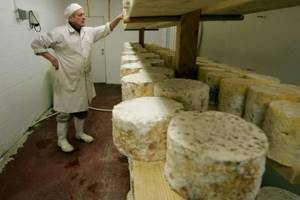
There is a beautiful legend about the origin of blue cheese. A shepherd was tending sheep in the Roquefort mountains and saw a beautiful girl in the distance. He ran after a wonderful vision, leaving his lunch - bread and sheep's milk cheese - right at the camp site - in a cave. He searched for her for many days and weeks, and when he returned, he found his rations moldy. But hunger tormented him so much that he pounced on the spoiled cheese and ate it all. He even liked the taste of the cheese.

There are several aspects to consider when choosing cheese.
- Blue mold produces a specific smell. It is reminiscent of the smell of fresh mushrooms. A mossy aftertaste is also a characteristic sign of a quality product. If such cheese smells not of mushrooms, but of ammonia, it means that its expiration date has expired or the storage conditions have been violated.
- The appearance of the product should be attractive : blue veins resemble stains on marble, turquoise inclusions are evenly distributed throughout the cut. You should not buy cheese if its entire surface is covered with mold; this is not an indicator of quality.
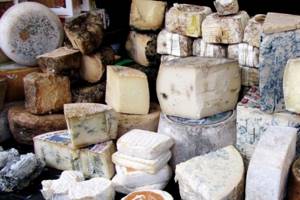
Beneficial features
This is a highly nutritious cheese - 100 g of product contains at least 350 kcal. So those who are on a diet and want to lose weight should forget about including it in their daily diet. For ordinary people, this is a great snack option. A nutritious and healthy product can be consumed without harm to health in an amount of no more than 50 g per day.
The benefits of cheese depend entirely on its composition.
- Amino acids (arginine, tryptophan, valine, etc.) regenerate and rejuvenate tissues.
- The high content of calcium and phosphorus helps strengthen bones and joints and enrich the blood composition. This is especially valuable during pregnancy, when a woman needs an increased supply of these substances to her body. However, you should consume cheese to a minimum: excessive consumption of the product can cause a disease such as listeriosis.
- Lecithin has a beneficial effect on the nervous system and digestion.
- Vitamin K thins the blood and promotes wound healing, stimulates the work of the heart muscle and blood vessels. During PMS and in cases of depression, such cheese will help activate blood flow and promote better well-being.
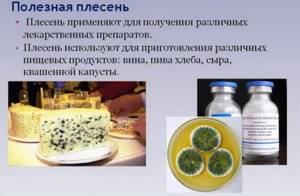
Blue cheese is a way out for people who have individual lactose intolerance. Thanks to its increased calorie content, it will help build muscle mass. People seeking to acquire it quickly, including athletes and those adapting after injuries, should attach particular importance to including such cheese in their diet.
In old age, it is useful to eat blue cheese. In addition to the usual benefits, it will bring additional resistance in the fight against diseases such as atherosclerosis, osteoporosis, heart failure and others.

Cheese Pesto green
They say that everything new is just well-forgotten old. This statement applies one hundred percent to green Pesto cheese.
Pesto cheese is an exquisite variety of cheese, the name of which comes from the sauce of the same name made from basil, pine nuts, olive oil and garlic. Italian pesto sauce has always enjoyed enviable popularity and demand among consumers.
Dutch cheese makers decided to create a new type of cheese that would resemble the taste of the famous pesto sauce. The producers did an excellent job. Nowadays, green cheeses, including pesto, are quickly gaining popularity.
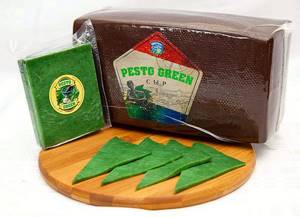
Parmesan and Pecorino cheese are usually used to make this cheese. Dutch cheesemakers decided to use the fame of pesto sauce to benefit a new type of cheese.
Green Pesto cheese is prepared in a similar manner to that used for Gouda cheese. To begin with, milk is combined with sourdough and rennet, and then basil, garlic and other herbs are added there. At a certain temperature, the mass begins to curdle and then thick enzymes are separated from it. They are then washed to remove the whey, put together into a specific shape and placed under a press to remove all unnecessary whey.
When the cheese becomes hard, it is placed in a certain brine for several days, then dried and sent to special storage facilities for ripening for a year. It is very important that they have a humidity of at least 90% and a temperature of no more than 12 degrees. The result is green cheese with a small number of eyes, which are visible on the cut of the product.
The first green Schabziger cheese was made in the Middle Ages in the Alpine region of Switzerland.
It is noteworthy that green cheese was widespread in the USSR. We think that people of the older generation remember very well the small bags in which they sold already grated cheese, which had a bright green color.
Pesto cheese has a rather specific taste. Moreover, the specificity lies in the fact that the product has a mild cheese taste with subtle notes of basil.
Gourmets say that green pesto cheese can be classified as a delicious and light snack that goes well with exclusive brands of wine. Agree that an ordinary type of cheese is hardly suitable for an ordinary accompaniment.
There are several varieties of green cheese, the most popular of which is Baziron. This cheese is made from cow's milk with the addition of basil and garlic, as well as pine nuts.
Green pesto basiron cheese is a type of hard cheese made from cow's milk. The distinctive green color of the cheese is given by basil, as well as other herbs that are used in the cheese making process.
The taste of green pesto basiron cheese is reminiscent of Italian pesto sauce. The aroma of pesto basiron cheese has subtle garlic and herbal notes. In addition, the pesto baziron green cheese contains pine nuts, which are also characteristic of pesto sauce. This ingredient gives pesto cheese even more piquancy and zest in taste.
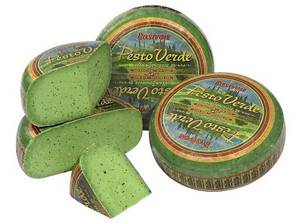
Pesto cheese has found wide use in cooking, just like its Italian counterpart of the same name. Typically, green pesto cheese is used as a snack or dessert. Green cheese will always stand out due to its unusual taste, color and aroma.
The beautiful and unusual color for such products determines the use of green Pesto cheese in cheese plates and snacks served at various events. This product goes well with white wine and champagne.
In addition, green Pesto cheese can be used as a separate snack, as well as for preparing a variety of sandwiches, pizza, spaghetti, first courses, etc. It is also included in recipes for salads and sauces that go well with both fish and meat dishes.
Italians liked the new type of Dutch green cheese. In modern Italian culinary tradition, pesto sauce is made with the cheese of the same name and seasoned such famous dishes as Italian pasta, spaghetti, ravioli and pizza.
The calorie content of green pesto cheese is 380 kcal.
Energy value (ratio of proteins, fats, carbohydrates):
- proteins: 23 g (~92 kcal)
- fat: 32 g (~288 kcal)
- carbohydrates: 0 g (~0 kcal)
Energy ratio of BJU: 24%|76%|0%
The fat content of such a product is not more than 50%.
Green cheese has beneficial properties due to the presence of a large amount of vitamins (PP, A, E, C, B6, B12, B1, B2, folic acid) and minerals (phosphorus, potassium, sodium, magnesium, calcium, manganese, copper, zinc, iron).
When choosing Pesto cheese, pay attention to its composition; there should not be anything superfluous. It is best to buy it at retail outlets where sellers cut the cheese from the heads, in which case you can look at the date of manufacture.
As for storage, it will stay fresh for several days in the refrigerator. Pre-wrap it in cling film or canvas paper.
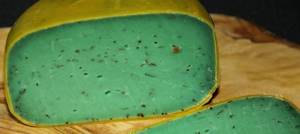
Reviews of Pesto cheese:
1. I decided to try the interesting-colored cheese, despite the fact that it contains dyes and a preservative, and I don’t like them, for a price of about 1200 rubles per kg. (Auchan) the lineup could have been better. The cheese tastes very good, hard, not too salty, not too spicy, the taste is closer to hard or semi-hard than aged cheeses and with a slight aftertaste of pesto sauce, nuts, however, are practically not felt. But the most important thing is its color: phenomenally green due to the presence of probably more dyes than basil. The color remains just as poisonous even after heat treatment.
In principle, the cheese is quite good, it looks beautiful on the table and in dishes, but its taste is quite mediocre for such a price, I would not hesitate to exchange it for yellow-cream Parmesan and a bunch of basil)). For the taste and composition not matching the price, I'm taking off 2 stars. This company also has cheese with poisonous red tomatoes. RoSSo, the composition there is even a little worse, but the taste is also okay. In any case, both cheeses are not 100% worth their money!
2. The cheese has a spicy taste, very similar to Pesto sauce. The peculiarity of this type of cheese is its rich green color and herbal aroma. Those who are accustomed to traditional types of cheese are unlikely to like it... However, cheese lovers will definitely appreciate it! The price is in the middle category (approximately 1200 rubles per kg). Baziron Pesto Verde cheese goes well with champagne or white wine. Perfectly decorates a holiday table. The drawback that I accidentally discovered for myself is the amount of chemicals (dyes). I thought it was because of the basil that it was so green))
3. Excellent spicy taste, unusual color, lightly salted. Suitable for white table wine. I bought it for the cheese tree for the New Year's table. Having tried it, I decided to buy it for the holidays. Price per kg - 1308.60 rub. I lower the rating only because of the composition, which includes E 509 - calcium chloride, E 251 - sodium nitrate, E 100 and E 141 - dyes.
Previous article: How to choose good butter Next article: Which milk is good for cheese?
Contraindications and harm
This type of cheese should not be given or introduced into the diet in the following cases:
- small children under 12 years of age are at risk of listeriosis - it is better to offer them regular cheeses;
- during pregnancy and lactation, unstable hormonal levels may change under the influence of the complex composition of the product;
- for peptic ulcers of the digestive system and gastritis, it is better to avoid blue cheeses due to their high acid and salt content;
- If you have high blood pressure, you should not get carried away with such cheeses, they are high in calories and are poorly digestible;
- for asthma and asthmatic attacks;
- if there is a tendency to polyarthritis;
- with the development of fungal diseases (such as thrush);
- Allergy sufferers should eat blue cheeses with caution; at least, they should start with minimal portions - from 10 g.
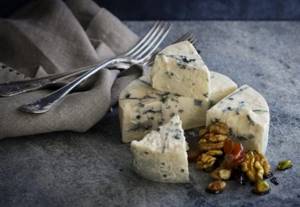
Contraindications and harms of green cheese Pesto

Children should be introduced to a new taste carefully. If you give your baby a piece and are distracted, he may choke on grains of dried flavoring additives. In addition, the high likelihood of allergic reactions should be taken into account. They can occur due to intolerance to lactose, basil, garlic and other components, the composition of which is known only to manufacturers.
The harm of green cheese Pesto is determined by the accompanying anamnesis. You should not supplement your diet with a tasty and beautiful product in case of diseases, the impetus for the development of which is increased acidity. Do not experiment with chronic pancreatitis and impaired liver function or with inflammatory processes of the urinary system.
There are restrictions for use during pregnancy and lactation. In the first case, spicy herbs can provoke uterine tone, and in the second, taste improvers affect the quality of breast milk. It becomes bitter and the baby may refuse the breast.
People who are overweight and lack time should reduce the recommended portion of basiron due to its high energy value. To burn the calories received from the daily dose, you will have to devote 1 hour a day to vigorous training. With active professional activity, this time may not be enough.
How is the product made?
Cow's milk is used to make cheese (sheep's milk only for Roquefort cheese). Cow's milk coagulates at a temperature of 30°C. The mass is placed in a mold, which is covered with a wooden plate. Periodically, the cheese circles are turned from side to side to drain the whey. After 7-10 days they are turned upside down. The curd-like mass is rubbed with salt and pierced with syringes filled with moldy fungi - this is how blue veins appear in the mass. The cheese heads are left to “ripen” so that mold can grow.
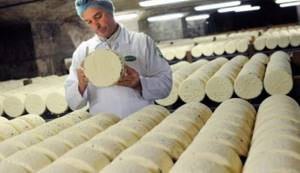
Blue cheese can also be made at home. You need to take cottage cheese and a sample of any blue cheese for sourdough. A teaspoon is enough. The seed is prepared using a blender by mixing moldy cheese with water. Sprinkle 2 tablespoons of salt onto the cottage cheese placed in a bowl, and pour the resulting starter on top. The product is left under light pressure overnight. In the morning you need to take out the product and make holes in the mass every 2-3 cm. Then the surface is rubbed with salt again, wrapped in gauze and left for a month in a cool place.
Recipe: Curd cheese with herbs. Calorie, chemical composition and nutritional value.
Nutritional value and chemical composition of “Curd cheese with herbs.”
The table shows the nutritional content (calories, proteins, fats, carbohydrates, vitamins and minerals) per 100 grams of edible portion.
| Nutrient | Quantity | Norm** | % of the norm in 100 g | % of the norm in 100 kcal | 100% normal |
| Calorie content | 231.3 kcal | 1684 kcal | 13.7% | 5.9% | 728 g |
| Squirrels | 19.1 g | 76 g | 25.1% | 10.9% | 398 g |
| Fats | 15.6 g | 56 g | 27.9% | 12.1% | 359 g |
| Carbohydrates | 2.8 g | 219 g | 1.3% | 0.6% | 7821 g |
| Organic acids | 1 g | ~ | |||
| Alimentary fiber | 0.1 g | 20 g | 0.5% | 0.2% | 20000 g |
| Water | 57.5 g | 2273 g | 2.5% | 1.1% | 3953 g |
| Ash | 2.147 g | ~ | |||
| Vitamins | |||||
| Vitamin A, RE | 158.8 mcg | 900 mcg | 17.6% | 7.6% | 567 g |
| Retinol | 0.128 mg | ~ | |||
| beta carotene | 0.217 mg | 5 mg | 4.3% | 1.9% | 2304 g |
| Vitamin B1, thiamine | 0.044 mg | 1.5 mg | 2.9% | 1.3% | 3409 g |
| Vitamin B2, riboflavin | 0.283 mg | 1.8 mg | 15.7% | 6.8% | 636 g |
| Vitamin B4, choline | 78.58 mg | 500 mg | 15.7% | 6.8% | 636 g |
| Vitamin B5, pantothenic | 0.405 mg | 5 mg | 8.1% | 3.5% | 1235 g |
| Vitamin B6, pyridoxine | 0.174 mg | 2 mg | 8.7% | 3.8% | 1149 g |
| Vitamin B9, folates | 29.085 mcg | 400 mcg | 7.3% | 3.2% | 1375 g |
| Vitamin B12, cobalamin | 1.143 mcg | 3 mcg | 38.1% | 16.5% | 262 g |
| Vitamin C, ascorbic acid | 2.75 mg | 90 mg | 3.1% | 1.3% | 3273 g |
| Vitamin D, calciferol | 0.588 mcg | 10 mcg | 5.9% | 2.6% | 1701 g |
| Vitamin E, alpha tocopherol, TE | 0.39 mg | 15 mg | 2.6% | 1.1% | 3846 g |
| Vitamin H, biotin | 9.628 mcg | 50 mcg | 19.3% | 8.3% | 519 g |
| Vitamin K, phylloquinone | 2.2 mcg | 120 mcg | 1.8% | 0.8% | 5455 g |
| Vitamin RR, NE | 3.8269 mg | 20 mg | 19.1% | 8.3% | 523 g |
| Niacin | 0.391 mg | ~ | |||
| Macronutrients | |||||
| Potassium, K | 127.69 mg | 2500 mg | 5.1% | 2.2% | 1958 |
| Calcium, Ca | 148.22 mg | 1000 mg | 14.8% | 6.4% | 675 g |
| Silicon, Si | 0.054 mg | 30 mg | 0.2% | 0.1% | 55556 g |
| Magnesium, Mg | 21.98 mg | 400 mg | 5.5% | 2.4% | 1820 |
| Sodium, Na | 507.11 mg | 1300 mg | 39% | 16.9% | 256 g |
| Sera, S | 200.9 mg | 1000 mg | 20.1% | 8.7% | 498 g |
| Phosphorus, Ph | 214.7 mg | 800 mg | 26.8% | 11.6% | 373 g |
| Chlorine, Cl | 528.43 mg | 2300 mg | 23% | 9.9% | 435 g |
| Microelements | |||||
| Aluminium, Al | 43.2 mcg | ~ | |||
| Bor, B | 0.2 mcg | ~ | |||
| Vanadium, V | 0.3 mcg | ~ | |||
| Iron, Fe | 0.87 mg | 18 mg | 4.8% | 2.1% | 2069 g |
| Yod, I | 9.32 mcg | 150 mcg | 6.2% | 2.7% | 1609 g |
| Cobalt, Co | 3.658 mcg | 10 mcg | 36.6% | 15.8% | 273 g |
| Lithium, Li | 0.068 mcg | ~ | |||
| Manganese, Mn | 0.0562 mg | 2 mg | 2.8% | 1.2% | 3559 g |
| Copper, Cu | 72.15 mcg | 1000 mcg | 7.2% | 3.1% | 1386 g |
| Molybdenum, Mo | 7.998 mcg | 70 mcg | 11.4% | 4.9% | 875 g |
| Nickel, Ni | 0.193 mcg | ~ | |||
| Tin, Sn | 10.36 mcg | ~ | |||
| Rubidium, Rb | 0.3 mcg | ~ | |||
| Selenium, Se | 28.386 mcg | 55 mcg | 51.6% | 22.3% | 194 g |
| Strontium, Sr | 16.25 mcg | ~ | |||
| Fluorine, F | 35.8 mcg | 4000 mcg | 0.9% | 0.4% | 11173 g |
| Chromium, Cr | 2.99 mcg | 50 mcg | 6% | 2.6% | 1672 g |
| Zinc, Zn | 0.5468 mg | 12 mg | 4.6% | 2% | 2195 g |
| Digestible carbohydrates | |||||
| Starch and dextrins | 0.003 g | ~ | |||
| Mono- and disaccharides (sugars) | 2.8 g | max 100 g | |||
| Essential amino acids | |||||
| Arginine* | 0.139 g | ~ | |||
| Valin | 0.136 g | ~ | |||
| Histidine* | 0.06 g | ~ | |||
| Isoleucine | 0.106 g | ~ | |||
| Leucine | 0.19 g | ~ | |||
| Lysine | 0.159 g | ~ | |||
| Methionine | 0.074 g | ~ | |||
| Methionine + Cysteine | 0.127 g | ~ | |||
| Threonine | 0.108 g | ~ | |||
| Tryptophan | 0.035 g | ~ | |||
| Phenylalanine | 0.115 g | ~ | |||
| Phenylalanine+Tyrosine | 0.199 g | ~ | |||
| Nonessential amino acids | |||||
| Alanin | 0.125 g | ~ | |||
| Aspartic acid | 0.217 g | ~ | |||
| Glycine | 0.074 g | ~ | |||
| Glutamic acid | 0.312 g | ~ | |||
| Proline | 0.071 g | ~ | |||
| Serin | 0.164 g | ~ | |||
| Tyrosine | 0.085 g | ~ | |||
| Cysteine | 0.051 g | ~ | |||
| Sterols (sterols) | |||||
| Cholesterol | 128.9 mg | max 300 mg | |||
| Saturated fatty acids | |||||
| Saturated fatty acids | 9.1 g | max 18.7 g | |||
| 4:0 Oil | 0.099 g | ~ | |||
| 6:0 Kapronovaya | 0.154 g | ~ | |||
| 8:0 Caprylic | 0.118 g | ~ | |||
| 10:0 Kaprinovaya | 0.29 g | ~ | |||
| 12:0 Lauric | 0.219 g | ~ | |||
| 14:0 Miristinovaya | 0.94 g | ~ | |||
| 15:0 Pentadecane | 0.002 g | ~ | |||
| 16:0 Palmitinaya | 2.916 g | ~ | |||
| 17:0 Margarine | 0.005 g | ~ | |||
| 18:0 Stearic | 1.043 g | ~ | |||
| 20:0 Arakhinovaya | 0.096 g | ~ | |||
| Monounsaturated fatty acids | 4.823 g | min 16.8 g | 28.7% | 12.4% | |
| 14:1 Myristoleic | 0.145 g | ~ | |||
| 16:1 Palmitoleic | 0.286 g | ~ | |||
| 17:1 Heptadecene | 0.002 g | ~ | |||
| 18:1 Oleic (omega-9) | 2.913 g | ~ | |||
| 20:1 Gadoleic (omega-9) | 0.089 g | ~ | |||
| Polyunsaturated fatty acids | 0.721 g | from 11.2 to 20.6 g | 6.4% | 2.8% | |
| 18:2 Linolevaya | 0.357 g | ~ | |||
| 18:3 Linolenic | 0.065 g | ~ | |||
| 20:4 Arachidonic | 0.026 g | ~ | |||
| Omega-3 fatty acids | 0.1 g | from 0.9 to 3.7 g | 11.1% | 4.8% | |
| Omega-6 fatty acids | 0.7 g | from 4.7 to 16.8 g | 14.9% | 6.4% |
The energy value of curd cheese with herbs is 231.3 kcal.
- Serving = 30 g (69.4 kcal)
Primary Source: Created in the application by the user. Read more.
** This table shows the average levels of vitamins and minerals for an adult. If you want to know the norms taking into account your gender, age and other factors, then use the “My Healthy Diet” application.
